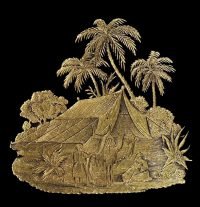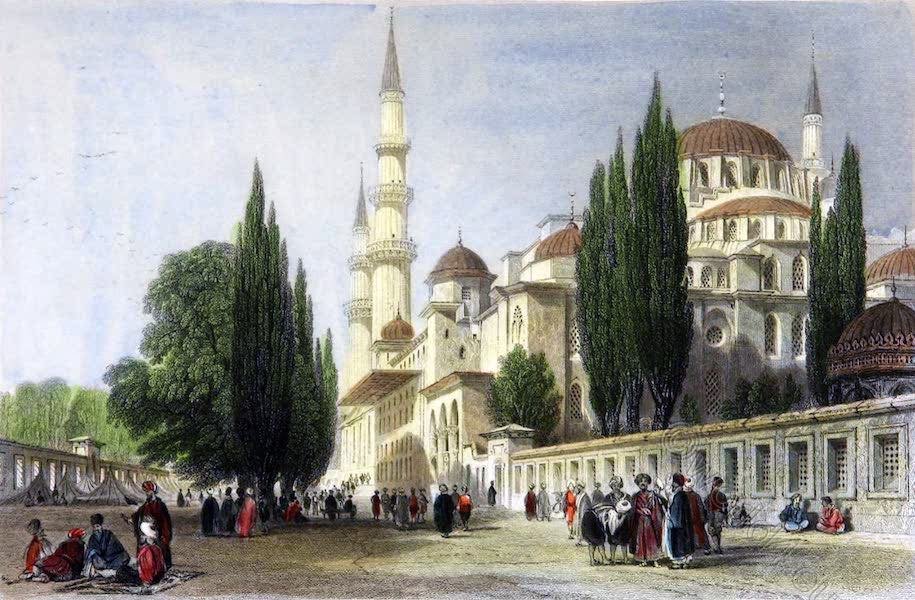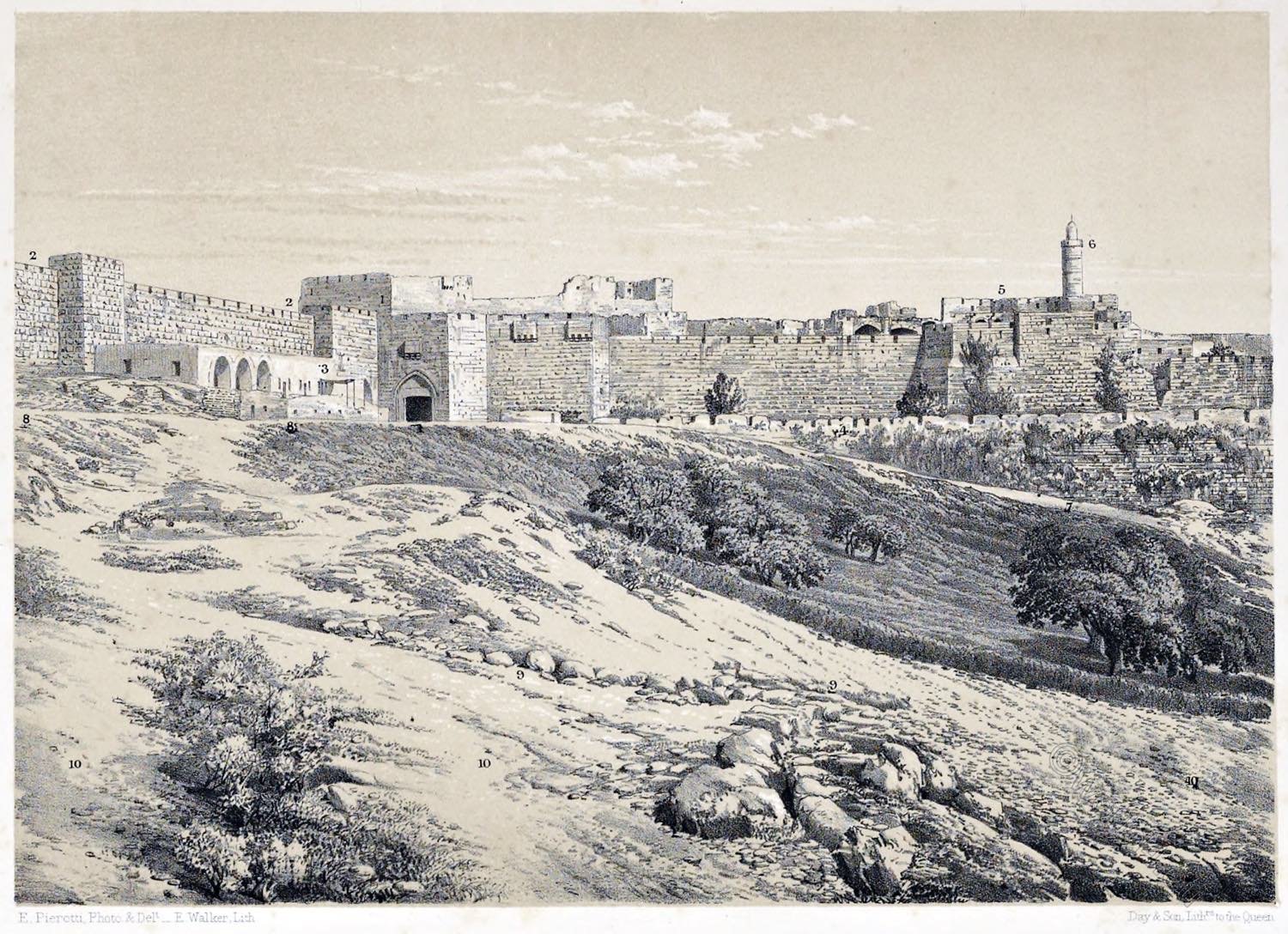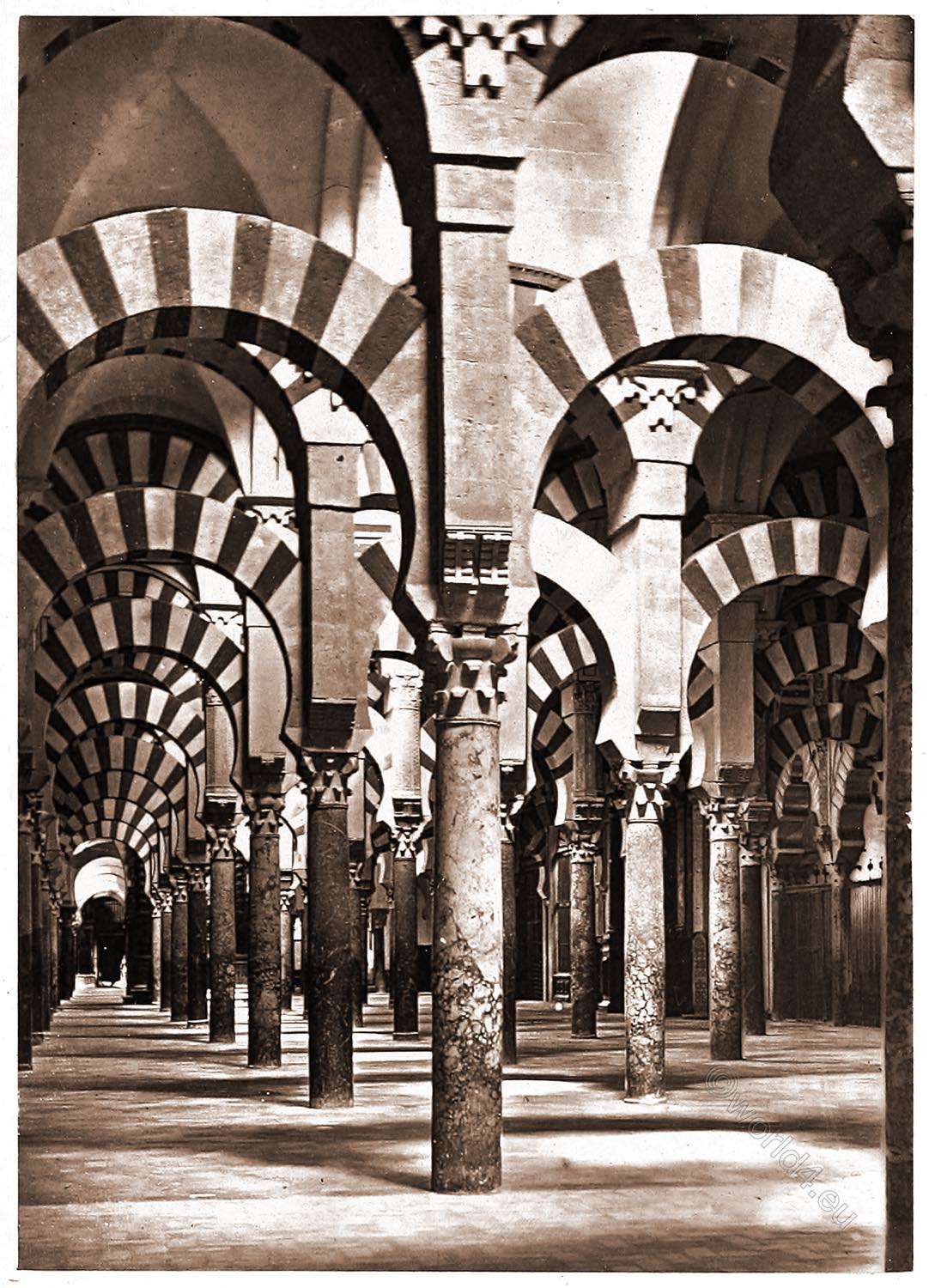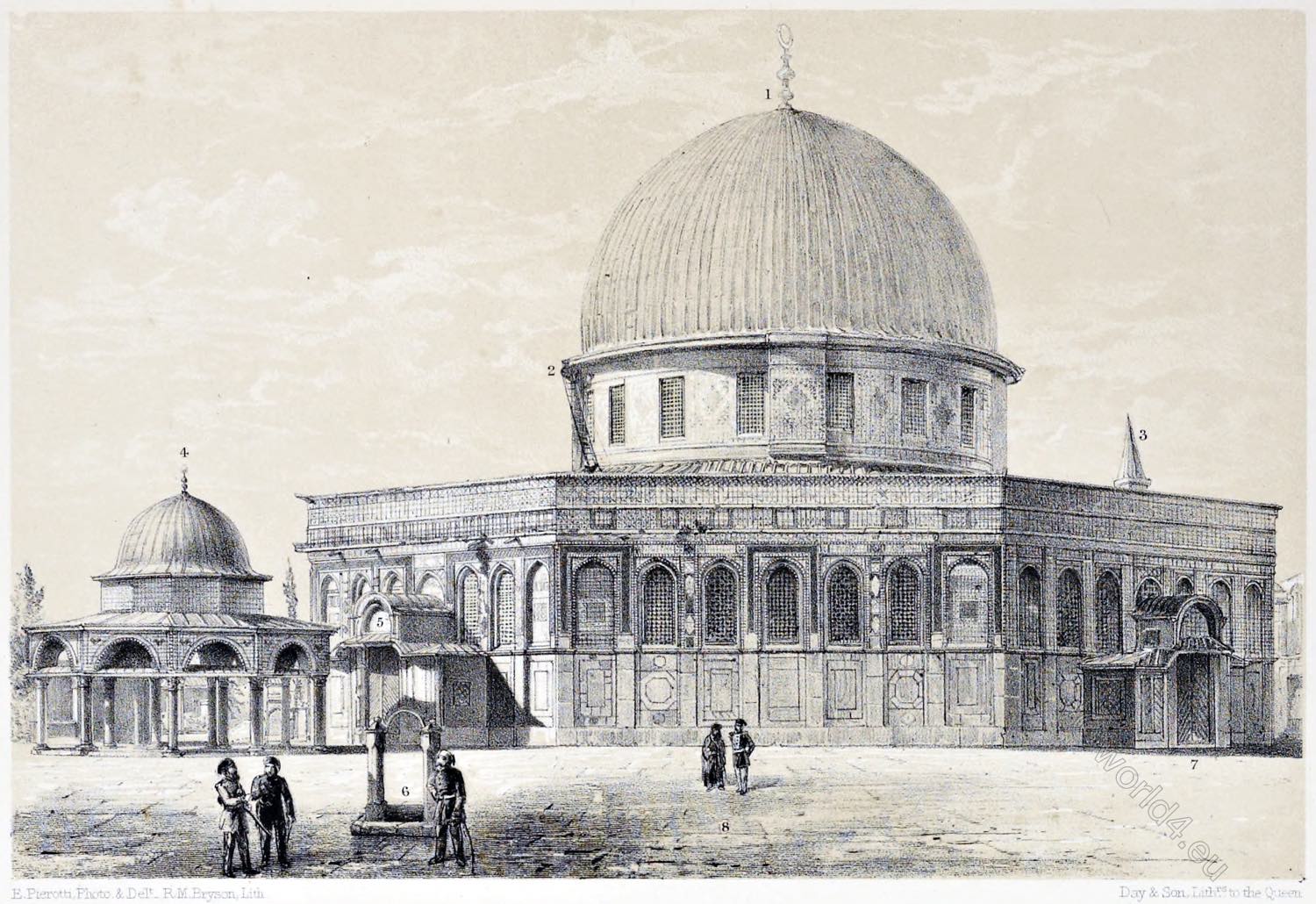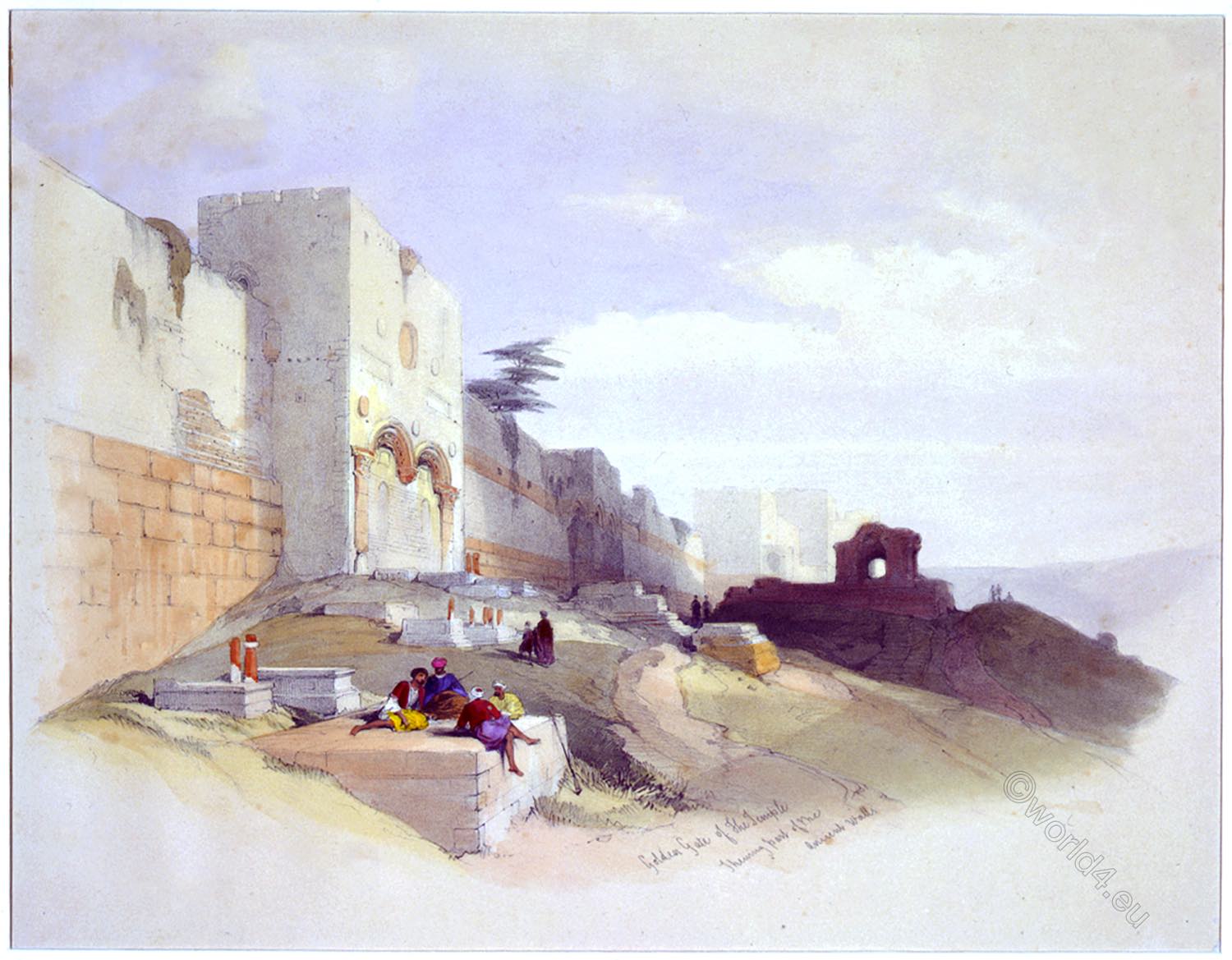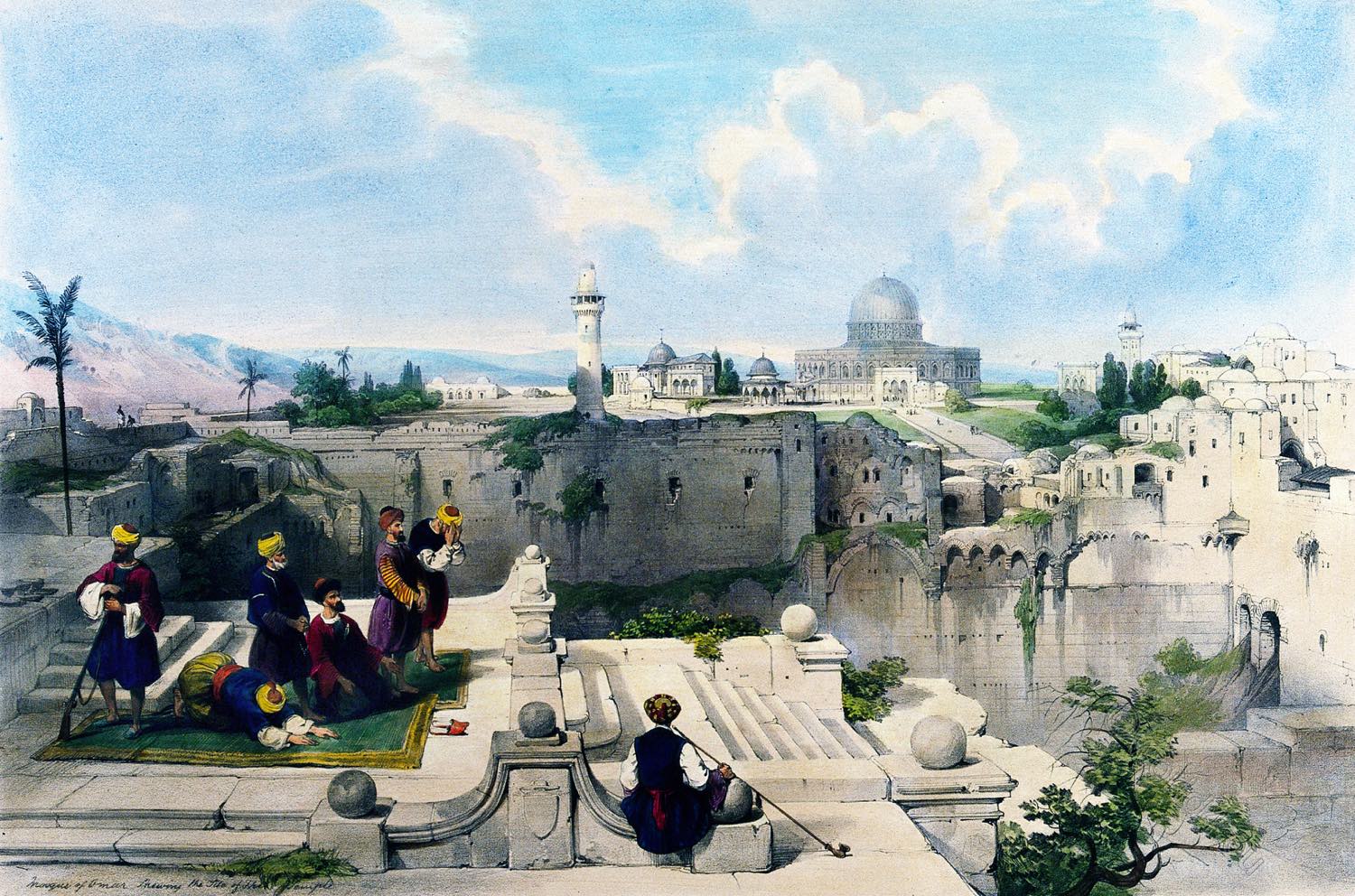
Plate 8 from Volume 1
A group of worshippers at the site of a temple, with Dome of the Rock in the distance. The patio overlooks the courtyard of the Church of the Holy Sepulchre with the minaret of the Mosque of Omar at centre. In the distance, the Dome of the Rock dominated the skyline. In addition to the men in prayer, one man sits smoking a long pipe while another, a guard, stands at ease, his arms resting on the barrel of his long rifle.
THE MOSQUE OF OMAR, ON THE ANCIENT SITE OF THE TEMPLE
by David Roberts.
This fine monument of the style of building under the Caliphate stands on Mount Moriah. It is recorded by the Arab historian, Seid Eben Batrik, that when the Caliph Omar took Jerusalem, the conqueror inquired of the Patriarch Sophronius,*) which would be the most fitting site for a mosque. The patriarch, by a choice which it is now difficult to under- stand, led him to the ruins of the Temple. Successive caliphs enlarged and adorned the mosque.
*) Sophronius of Jerusalem (c. 560 in Damascus – March 11, 638 (?) in Jerusalem), called Sophronius the Sophist, was Patriarch of Jerusalem from 634 until his death. Before taking this episcopal seat, he was a monk and, as a theologian, one of the main representatives of Orthodox doctrine in the controversy over the nature of Jesus and his acts of will.
At the capture of Jerusalem by the Crusaders it was consecrated as a Christian Church, but on falling into the hands of Saladin, it became a mosque again. The lively narrative of Dr. Richardson, who had contrived to evade Mohammedan vigilance, gives us the best notice of the structure. Enveloped in a black robe to avoid observation, and attended by an interpreter, he ascended the southern hope of Mount Moriah, and entered the Haram Schereef, (or “noble Retirement for Devotion,”) an inclosure of 1489 feet by 995, in the centre of which stands the Sakhara, (or “Shut Up,”) the Mosque of Omar.
“After viewing the building, we then,” the narrative proceeds, “hied out of the Gate of Paradise (Bab-el-Jenne), passed by the ‘Judgment-Seat of Solomon,’ and descended into the inclosure. Here we put on our shoes, and walked through the trees, to a house adjoining the wall of the inclosure, in which is said to be the throne of Solomon.
From this we ascended by a stair to the top of the wall, and sat upon the stone on which Muhammad is to sit at the day of judgment, to judge the reembodied spirits assembled beneath him in the Valley of Jehoshaphat. Descending from this seat of tremendous anticipation, we walked along the front of El Aksa, the other mosque, which occupies the side of the inclosure.”
A visit in daylight, in which he was accompanied by some Turks of rank, enabled him to enjoy a still more accurate view. The ground is verdurous, and scattered over with orange, olive, cypress, and other trees.
“In the sacred retirement of this spot, the followers of the Prophet delight to saunter or repose, and arrayed in the gorgeous costume of the East, add much to the beauty and interest of the scene, which they seem unwilling to quit either in going to, or returning from, the place of prayer.
Round the edge of the Stoa-Sakhara, or platform of the mosque, are many small houses, for private prayer, and other purposes connected with the principal building; but the Sakhara itself is the chief ornament of the whole. It is a regular octagon of about sixty feet a side.
It is entered by four gates, and the walls are faced to a certain height with marble; the sides are paneled, and the upper story of this elegant building is faced with small tiles eight or nine inches square, and painted white, yellow, green, and blue. On each side there are seven well-proportioned windows, except where the front interferes.
The whole is extremely light and beautiful, and from the mixture of the soft colours above, and the blue and white tinge of the marble below,” says the Doctor, “I was more delighted with it than any building I ever saw.” It is now, however, much defaced, and, like most of the Mohammedan structures in Palestine, is sinking into decay.
The front group consists of Greek Christians, pilgrims to Jerusalem and praying towards the Holy Sepulchre (also called the Church of the Resurrection or Church of the Anastasis). They stand on a terrace of the dilapidated Church of St. Anna, which is built over the grotto shown as the birth-place of the Virgin. The Mount of Olives is partially seen on the left. In the same direction is the principal entrance to the mosque, which no Christian is allowed to pass.
The view is taken from the terrace, looking down to the Pool of Bethesda; the lower portion of the walls is ancient, (the upper part Saracenic,) and may have formed part of the Tower of Antonia.
1 Roberts’s Journal. Robinson, Biblical Researches, vol. i. p. 415, &c.
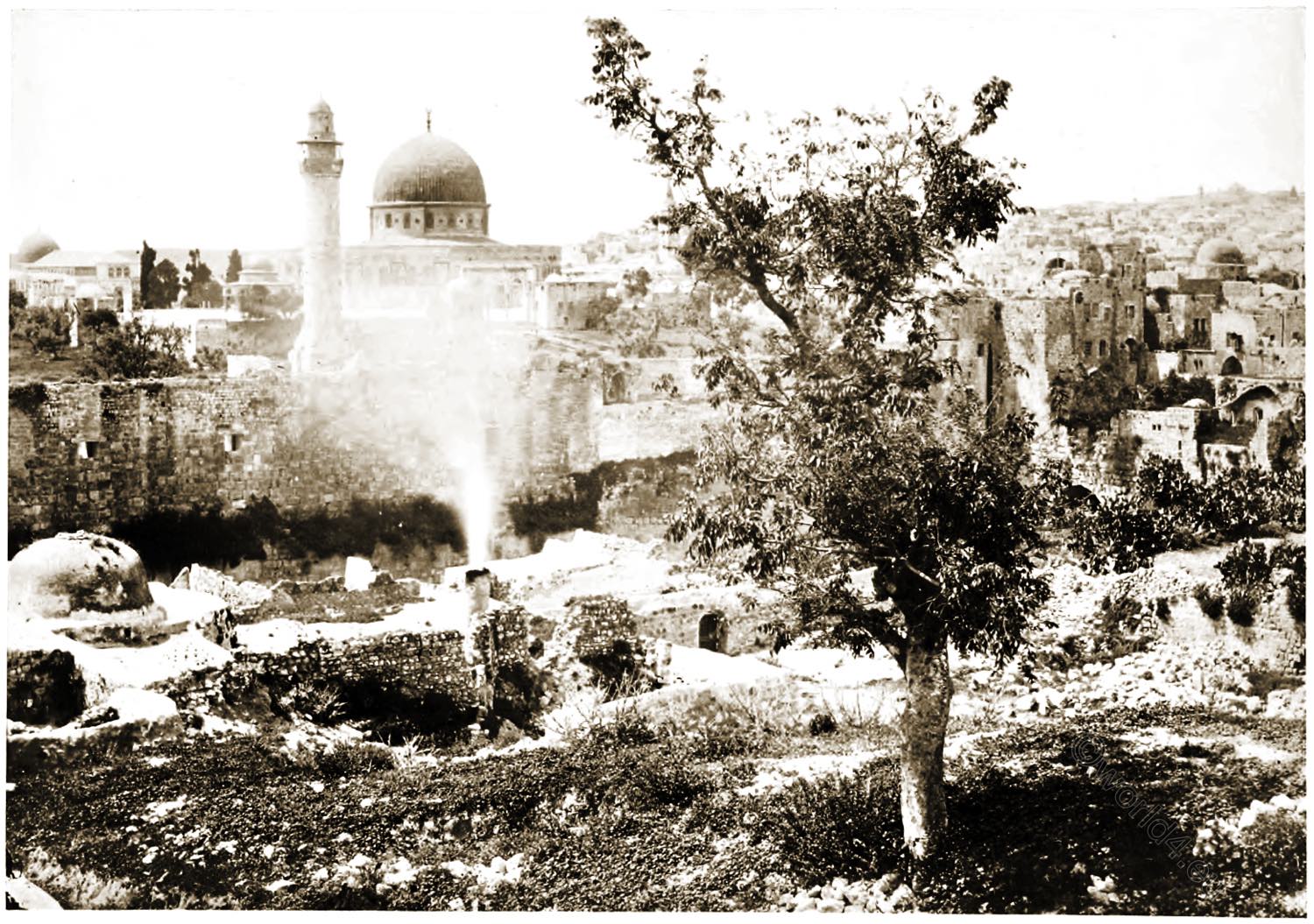
THE MOSQUE OF OMAR, &c. JERUSALEM, FROM THE CITY WALLS, 1857
by Francis Frith (English, 1822 – 1898); Jerusalem, Palestine.
THIS view is taken from a point upon the walls very near to St. Stephen’s Gate. It embraces the deep wall of the Pool of Bethesda, the Mosques of Omar and Aksa, the minaret from which the muezzin, or call to prayers, is proclaimed, and (on the right) the dome-topped houses of the modern city rising towards Mount Zion.
We now resume the historical sketch. The importance and splendor of Jerusalem was considerably lessened after the death of Solomon, under whose son, Rehoboam, ten of the tribes rebelled, and went no longer up to Jerusalem to worship.
After this period the kingdom of Judah was almost alternately ruled by good kings, and by those who were idolatrous and evil disposed; and the condition of Jerusalem was very much moulded by these changes.
Under Rehoboam it was conquered by Shishak, king of Egypt (b.c.973), who pillaged the treasures of the temple (2 Chron. xii. 9). Under Amaziah it was taken by Jehoash, king of Israel, who broke down 400 cubits of the wall of the city, and took away all the gold and silver, and all the vessels of the temple, &c. (2 Kings xiv. 13, 14).
Uzzah, son of Amaziah, who at first reigned well, built towers in Jerusalem at the “corner gate,” at the “valley gate,” and at the turning of the wall, and fortified them (2 Chron. xxvi. 9).
His son Jotham built the high gate of the temple, and many other structures (2 Chron. xxvii. 3, 4). Hezekiah (b.c. 728) added to the other honors of his reign that of an improver of Jerusalem. His most important work in that character was the stopping of the upper watercourse of Gihon, and bringing its waters by a subterraneous aqueduct to the west side of the city (2 Chron. xxxii. 33).
Hezekiah’s son, Manasseh, in his latter and best years, built a strong and very high wall on the west side of the city. For about one hundred years after this period, no serious alteration is recorded in the state of Jerusalem.
Then, for the abounding iniquities of the nation, it was abandoned to destruction. After a siege of three years it was taken by Nebuchadnezzar, who razed its walls, and destroyed its temple and palaces by fire (2 Kings xxv.; 2 Chron. xxxvi.) At this period the ten tribes forming the kingdom of Israel had been already upwards of one hundred and thirty years transported to Assyria; Judah was now exiled to Babylon; and the Castle of David, the Temple of Solomon, and the entire city, lay in utter, and to all human appearance hopeless, ruin until the prophetic period of its restoration.
With regard to this captivity there existed two prophecies of remarkable precision. The first was by Jeremiah (xxv. 9, 12), in which the duration of the captivity is limited to seventy years; the other by Isaiah (xliv. 28), where the very name of the appointed deliverer is mentioned, “Thus saith the Lord of Cyrus, He is my shepherd, and shall perform all ray pleasure : even saying to Jerusalem, Thou shalt be built; and to the temple, Thy foundation shall be laid.” Daniel, who shared in the captivity, lived to see the reign of Cyrus. This prince issued a most remarkable proclamation, commanding the restoration of the temple, &c. He appointed Sheshbazzar as Prince of Judah, who led to Jerusalem 42,360 people besides their servants, of whom there were 7337 (Ezra i. 5—11).
In the following year, when the foundation of this second temple was laid, it is recorded that “the people shouted for joy, but many of the Levites, who had seen the first temple, wept with a loud voice” (Ezra iii. 2, 12). The temple was not completed until the sixth year of the reign of Darius, having been delayed by the orders of Artaxerxes, who was influenced to this interference by the jealous intrigues of the Samaritans.
Source:
- The Holy Land, Syria, Idumea, Arabia, Egypt, & Nubia, by David Roberts, George Croly, William Brockedon. London: Lithographed, printed and published by Day & Son, lithographers to the Queen. Cate Street, Lincoln’s Inn Fields, 1855.
- Egypt and Palestine by Francis Frith, 1858. Publisher: London, James S. Virtue, City Road and Ivy Lane. New York: 26, John Street.
Continuing
Discover more from World4 Costume Culture History
Subscribe to get the latest posts sent to your email.

